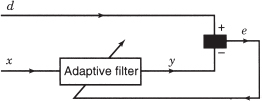7
Adaptive Filters
- Adaptive structures
- The linear adaptive combiner
- The least mean squares (LMS) algorithm
- Programming examples for noise cancellation and system identification using C code
Adaptive filters are best used in cases where signal conditions or system parameters are slowly changing and the filter is to be adjusted to compensate for this change. A very simple but powerful filter is called the linear adaptive combiner, which is nothing more than an adjustable FIR filter. The LMS criterion is a search algorithm that can be used to provide the strategy for adjusting the filter coefficients. Programming examples are included to give a basic intuitive understanding of adaptive filters.
7.1 INTRODUCTION
In conventional FIR and IIR digital filters, it is assumed that the process parameters to determine the filter characteristics are known. They may vary with time, but the nature of the variation is assumed to be known. In many practical problems, there may be a large uncertainty in some parameters because of inadequate prior test data about the process. Some parameters might be expected to change with time, but the exact nature of the change is not predictable. In such cases it is highly
Figure 7.1. Basic adaptive filter structure.

desirable to design the filter to be self-learning so that it can adapt itself to the situation at hand.
The coefficients of an adaptive filter ...

